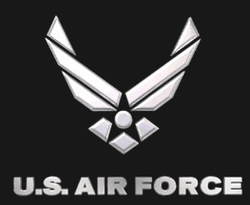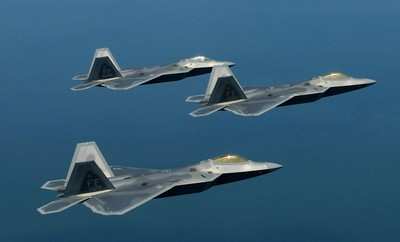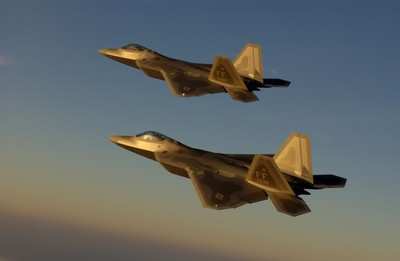 The first Air Force pilots selected
to fly the F-22 Raptor without previous fighter experience entered
the 63rd Fighter Squadron for the Raptor Lead-in course Jan. 14, at
Luke Air Force Base, AZ. The four pilots are 1st Lt. Austin
Skelley, 1st Lt. Ryan Shelhorse, 1st Lt. Marcus McGinn, and 1st Lt.
Dan Dickinson.
The first Air Force pilots selected
to fly the F-22 Raptor without previous fighter experience entered
the 63rd Fighter Squadron for the Raptor Lead-in course Jan. 14, at
Luke Air Force Base, AZ. The four pilots are 1st Lt. Austin
Skelley, 1st Lt. Ryan Shelhorse, 1st Lt. Marcus McGinn, and 1st Lt.
Dan Dickinson.
Prior to arriving at Luke Air Force Base, the four pilots were
part of a pool of eight candidates hoping to be selected as the
first students to go directly to the F-22. F-22 pilots currently
flying the airframe had previous flying experience in other fighter
aircraft. The Raptor Lead-in course is a five-week opportunity for
the four new pilots to experience flying a high-G, high performance
aircraft with an instructor in the back seat before taking the
stick of the $169 million, single-seat F-22 by themselves, said
Maj. Daniel Munter, a 56th Training Squadron instructor pilot.
"This course is designed to be an intermediate step to (the
pilots) taking the F-22 up for the first time and being
successful," Major Munter said. Pilots and other instructors from
the 56th Fighter Wing have been working since early 2007 on this
course, which is not necessarily designed to teach the pilots how
to fly the F-16 Fighting Falcon, but rather to give them experience
in a high-G environment while familiarizing them with other aspects
of fighter aviation which were unavailable to them during their
previous training.
After undergraduate pilot training, the eight newly-graduated
pilots were sent to Randolph AFB, Texas, for the Introduction to
Fighter Fundamentals Course. That course familiarized them with
fighters via the T-38 Talon trainer aircraft. By the end of IFF,
the final four were selected to become F-22 pilots. By learning to
push the envelope in the F-16, the Raptor Lead-in course is
designed to help them be successful in the maneuvering dynamics of
the F-22, Major Munter said.
One of the major benefits to their F-16 familiarization is the
similarities of the two aircraft, specifically the side-stick
controls. Other aircraft in the Air Force inventory are controlled
with the controls between the pilot's legs. The fly-by-wire system
is unique to these two fighter aircraft. Other items the students
will learn more about while at Luke AFB include night flying, day
and night landing, air-to-air refueling and increasing their
ability to perform the anti-G straining maneuver. This last item is
key, Major Munter said. While the T-38 Talon is quick and
maneuverable, it may have pushed the pilots to experience six Gs,
or six times the force of gravity. While flying the F-16, the
pilots will experience up to nine Gs, making their transition to
the F-22 easier to handle.

This course is exactly what instructors at Luke AFB are used to
doing, said Brig. Gen. Noel T. "Tom" Jones, the 56th Fighter Wing
commander.
"You will get a lot of experience here from a fighter
perspective and an intelligence perspective that's very
transferable to the F-22," he said to the four pilots. For the new
pilots, the opportunity to fly the high-performance F-16 before
going on to the Air Force's most advanced fighter is something they
all look forward.

"Learning to fly an advanced fighter from world-class
instructors is going to be a great opportunity for our class as we
transition to the F-22," said Lieutenant Skelley, a native of Casa
Grande, Ariz. After completing the course here, the pilots will go
on to the 43rd Fighter Squadron at Tyndall AFB, Fla., where after
more than two years of training, they will take on the F-22. [ANN
salutes 2nd Lt. Bryan Bouchard, 56th Fighter Wing Public
Affairs]
 ANN's Daily Aero-Term (12.14.25): Local Airport Advisory (LAA)
ANN's Daily Aero-Term (12.14.25): Local Airport Advisory (LAA) Airborne 12.08.25: Samaritans Purse Hijack, FAA Med Relief, China Rocket Fail
Airborne 12.08.25: Samaritans Purse Hijack, FAA Med Relief, China Rocket Fail ANN's Daily Aero-Linx (12.15.25)
ANN's Daily Aero-Linx (12.15.25) Airborne 12.10.25: New Gulfstream, ATC Integrator, Outrageous FFZ User Fees
Airborne 12.10.25: New Gulfstream, ATC Integrator, Outrageous FFZ User Fees Airborne-NextGen 12.09.25: Amazon Crash, China Rocket Accident, UAV Black Hawk
Airborne-NextGen 12.09.25: Amazon Crash, China Rocket Accident, UAV Black Hawk





